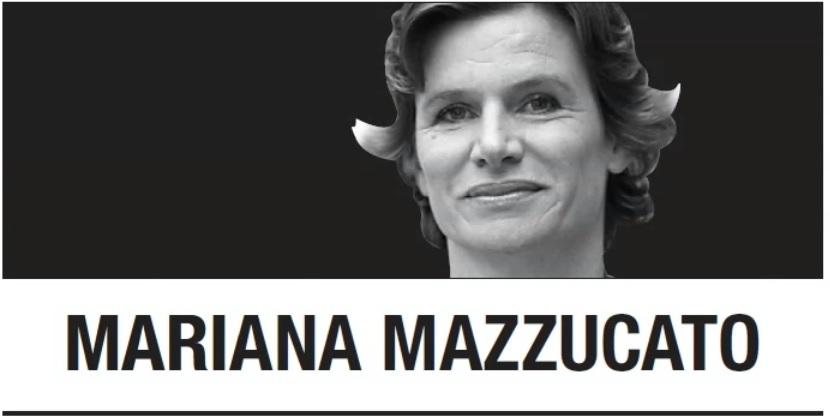[Mariana Mazzucato, Alan Donnelly] How to design a pandemic preparedness and response fund
By Korea HeraldPublished : April 26, 2022 - 05:31


With over two-thirds of the African continent still unvaccinated against COVID-19, it is clear that the global pandemic preparedness and response, or PPR, regime remains seriously underfunded and lacking in resilient, effective delivery systems. While the World Health Organization’s Access to COVID-19 Tools Accelerator has helped to address the gross inequity in access to testing, treatments, and vaccines, it lacks the financial backing needed to support low-income countries comprehensively.
Scientific and economic research has shown that a future airborne pandemic could kill millions of people and cause economic chaos, especially in the context of increased urbanization and intensifying climate change. The emergence of another novel pathogen is inevitable, and when it comes, it could well pose an existential threat to humanity. As with the battle against global warming, the costs of inaction are much greater than the costs of action.
Last October, the Italian G-20 Presidency issued a PPR road map to ensure that the world is better prepared for the next global health challenge. In the coming days, G-20 finance ministers and central bank governors will receive a progress report from the G-20 Joint Finance and Health Task Force, the body created to monitor performance.
A crucial next step is to create an effective, properly funded Financial Intermediary Fund. The WHO and the World Bank estimate that there is at least a $10.5 billion annual financing gap for PPR. We should regard that as the bare minimum amount of additional financing required each year to support equitable access to vaccines, testing and therapies, pathogen surveillance, research and development, manufacturing, and health infrastructure.
There is no good reason why the G-20 should not be able to muster another $10.5 billion per year. It is a tiny fraction of the trillions of dollars deployed to mitigate the current pandemic, not to mention the trillions that would be lost in the event of another global health crisis.
Still, to succeed, the FIF must also meet four specific conditions. First, it should not be financed through occasional pledging or replenishment initiatives, as these are too unreliable. Instead, governments must agree to provide the first five years of funding up front, while taking steps to build financial commitments to the FIF into their annual budgets.
This starter fund should promote innovative and blended finance mechanisms to leverage the FIF’s investments. There is no need to reinvent the wheel here. Governments, development banks, philanthropists, and corporations are already creating new partnerships to achieve net-zero emissions goals. G-20 leaders should establish an expert group to identify best practices from green financing models that could be deployed for investments in PPR.
Moreover, because low- and middle-income countries face tight fiscal constraints, any additional investments they make in their public-health and PPR systems should be recognized as in-kind contributions to the FIF (provided they are compatible with the fund’s overall objectives).
Second, the FIF must have an evaluation mechanism, based on agreed metrics of an investment’s socioeconomic impact, to ensure the efficient use of these new resources. Any such mechanism must give donors confidence that there is a measurable return on their long-term commitment to the FIF.
Third, the FIF’s funding must not undermine programs that are addressing other urgent public health needs. High-income countries’ contributions must be made in addition to existing official development assistance to ensure that the FIF isn’t poaching support.
Lastly, as the G-20 Rome Leaders’ Declaration recognized, the FIF must aim for universal access and inclusive governance to ensure that it has legitimacy in the eyes of low- and middle-income countries. For example, pharmaceutical innovation and production should be governed according to the principle of collective intelligence, which calls for the widest possible sharing of the underlying knowledge.
The FIF must move away from an outdated and inequitable donor-beneficiary framework. Representation within the FIF’s formal governance structure should be distributed equally across high-, middle- and low-income countries. There should also be a core of global and regional implementing institutions, such as the WHO and Africa Centers for Disease Control, as well as representation by independent experts from across society.
To avoid bureaucratic disputes between global governance bodies, the FIF should be hosted by the World Bank, with the WHO playing a leading role in strategy development and execution. At the same time, both organizations must recognize that the best way to build expertise and capacity is to encourage the widest involvement of all stakeholders in fully transparent partnerships.
This year’s Indonesian G-20 Presidency must ensure that the FIF comes to fruition. But first, those gathering this month for the spring World Bank and International Monetary Fund meetings must agree on the financing and architecture, ensuring that the FIF meets the four conditions outlined above.
If the COVID-19 pandemic has shown us anything, it is that we need a radical change in direction. A well-designed, fully funded PPR fund is a crucial step on the way to achieving the WHO’s mission of health for all.
Mariana Mazzucato, Alan Donnelly
Mariana Mazzucato is professor of innovation and public value at University College London. Alan Donnelly, a former member of the European Parliament, is founder and convenor of the G-20 Health and Development Partnership. -- Ed.
-
Articles by Korea Herald







![[Graphic News] More Koreans say they plan long-distance trips this year](http://res.heraldm.com/phpwas/restmb_idxmake.php?idx=644&simg=/content/image/2024/04/17/20240417050828_0.gif&u=)
![[KH Explains] Hyundai's full hybrid edge to pay off amid slow transition to pure EVs](http://res.heraldm.com/phpwas/restmb_idxmake.php?idx=644&simg=/content/image/2024/04/18/20240418050645_0.jpg&u=20240419100350)






![[From the Scene] Monks, Buddhists hail return of remains of Buddhas](http://res.heraldm.com/phpwas/restmb_idxmake.php?idx=652&simg=/content/image/2024/04/19/20240419050617_0.jpg&u=20240419175937)

![[KH Explains] Hyundai's full hybrid edge to pay off amid slow transition to pure EVs](http://res.heraldm.com/phpwas/restmb_idxmake.php?idx=652&simg=/content/image/2024/04/18/20240418050645_0.jpg&u=20240419100350)

![[Today’s K-pop] Illit drops debut single remix](http://res.heraldm.com/phpwas/restmb_idxmake.php?idx=642&simg=/content/image/2024/04/19/20240419050612_0.jpg&u=)